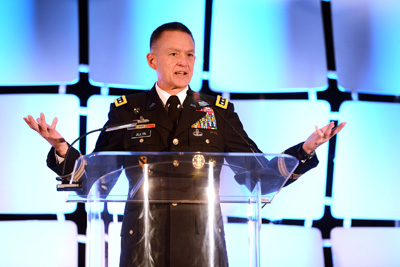By C. Todd Lopez
WASHINGTON (Oct. 26, 2016) -- In the future, defense contractors who want to build unmanned systems for the Army must focus on increased situational awareness, lightening the load on Soldiers and force-protection capabilities.
Vice Chief of Staff of the Army Gen. Daniel B. Allyn was the keynote speaker Wednesday morning at an Association for Unmanned Vehicle Systems International conference just walking distance from the Pentagon. He told a room full of defense industry insiders just exactly what the Army is looking for going forward when it comes to both ground-based and aerial unmanned systems.

For the Army to be interested, he said, new unmanned systems must first "increase situational awareness" for Soldiers.
"Going where manned systems cannot, thereby increasing standoff, survivability, and agility for our Soldiers in our units," he said.
The general pointed out that late next year, the Army will begin fielding improvements to the MQ-1C Grey Eagle unmanned aircraft, providing greater payload capacity and increased range.
"We are developing multi-functional electronic-warfare payloads for our Grey Eagles to sustain critical-information dominance on this future battlefield," Allyn said.
New unmanned systems must also lighten the Soldier's load. They must make it easier for Soldiers to operate physically, and must also be easier for Soldiers to operate, with less training and less complexity, Allyn said.
"Heavy loads increase fatigue and limit commanders' options in both space and duration," Allyn said. "Therefore, we are focused on capabilities like the Squad Multipurpose Equipment Transport, an unmanned system capable of carrying a squad's worth of equipment, life support and combat gear, with multi-functional flexibility for key contributions to power generation and casualty evacuation during dismounted operations."
While the SMET can carry the heavy gear for Soldiers, taking the burden off their backs, Allyn also said future unmanned systems must also lighten a Soldiers cognitive load. They must be less complicated to operate, require fewer types of operators, and less training. One solution, the One System Remote Video Terminal, can be used to operate more than one type of unmanned aerial system.
"This breakthrough technology, enabling a common interface for multiple types of unmanned systems, means that both Shadow and Grey Eagle operators, who today use different displays, will enjoy commonality, along with as-yet undeveloped unmanned systems, on the same interface," Allyn said. "This capability will provide commanders greater flexibility; they will reduce operator workload, and increase interoperability within the Army and the joint force."
Allyn also said future unmanned systems must help sustain the force with increased distribution, throughput and efficiency. He cited ongoing testing of the "Leader/Follower" capability, now being evaluated at Fort Bliss, Texas, as part of Army Warfighter Assessment 17.1, as an example.
"They must be capable of moving material to the battlefield, while providing commanders a broad array of distribution options," he said. The Leader/Follower capability puts a driver in but one vehicle in a convoy, with an additional four vehicles that can follow, unmanned -- they drive automatically, taking cues from the single manned vehicle.
"Similar to autonomous driving efforts being tested around the country, this capability, set to go into production by 2024, will reduce the threat to our Soldiers, increase commanders' range of options, and improve our sustainability and endurance," Allyn said.
Early evaluations of Leader/Follower, he said demonstrate that manned/unmanned teaming "isn't something that just works in the air, it works on the ground."
Future unmanned systems must also facilitate movement and maneuver, "the core business of our Army," Allyn said.
The Army is interested in "scalable control," he said, where UAV operators and recovery teams, for instance, can transfer control of systems to other Soldiers in other units that need assistance.
"This will enable ground combat units to positively control UAV assets, prioritizing efforts as needed, in support of a broader array of mission objectives," Allyn said. "It'll also free up UAV operators -- always in short supply -- for other missions."
Allyn also pointed to the Common Robotic System-Individual as an example of an unmanned system enhancing movement and maneuver. He said the man-portable CRS-I, which weighs less than 25 pounds, provides dismounted forces with ground-based intelligence, surveillance and reconnaissance, chemical, biological, radiological and nuclear detection, and explosive-ordinance disposal capabilities.
"Once fielded, this capability will provide our Soldiers with on-sight abilities that now reside only at higher command echelons," he said.
Finally, future unmanned systems must help "protect the force," Allyn said. Already, unmanned systems help secure bases and routes in theater, and unmanned robotics are used by explosive-ordnance disposal teams to diffuse improvised explosive devices.
"In the future, route clearance and interrogation systems will provide route clearance teams an unmanned semi-automated capability to interrogate, excavate and classify deeply-buried IEDs and caches," he said. "This will increase Soldier stand-off, and ability to detect and neutralize IED threats."